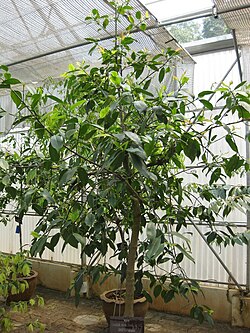Biology:Garcinia cowa
| Garcinia cowa | |
|---|---|

| |
| Scientific classification | |
| Kingdom: | Plantae |
| Clade: | Tracheophytes |
| Clade: | Angiosperms |
| Clade: | Eudicots |
| Clade: | Rosids |
| Order: | Malpighiales |
| Family: | Clusiaceae |
| Genus: | Garcinia |
| Species: | G. cowa
|
| Binomial name | |
| Garcinia cowa Roxb.
| |
Garcinia cowa, commonly known as cowa fruit or cowa mangosteen[2] is an evergreen plant with edible fruit native to Asia, India , Bangladesh, Myanmar, Malaysia, Vietnam, Laos, Cambodia, and southwest China. The tree is harvested from the wild for its edible fruits and leaves, which are used locally.[3] Flowers are yellow, male & female flowers are separated.[2]
It is locally known as Kau Thekera (কাও থেকেৰা) in Assamese, Kowa in Bengali and Malayalam, Kau in Manipuri.[2]
Uses
Culinary
The fruit can be eaten raw and has an acidic flavor. It is used in curries as a tamarind-like flavoring, as well as being used for making pickles. It can be made into slices and sun-dried as a way to preserve it. Its leaves can also be cooked and eaten.[3]
Folk medicine
In Thailand Garcinia cowa has been used in the local folk medicine, the bark as an antipyretic and antimicrobial, the latex as an antipuretic, and the fruits and leaves to improve blood circulation, as an expectorant for coughs and indigestion, and a laxative. The roots are believed to relieve fevers, and in East India, sun-dried slices of the fruit have been used as a treatment for dysentery.[4]
Anti-malarial
Studies have found that the bark contains five xanthones with anti-malarial properties in vitro against Plasmodium falciparum.[4]
Dyes and resins
The bark is also used to produce a yellow dye for clothes. The gum resin is used in varnishes.[citation needed]
See also
- Mangosteen
- Garcinia pedunculata
- Garcinia xanthochymus
- Garcinia lanceifolia
- Garcinia morella
- Garcinia assamica
- Garcinia dulcis
References
- ↑ Deepu, S.; Geethakumary, M.P. (2020). "Garcinia cowa". IUCN Red List of Threatened Species 2020: e.T61988928A61988973. doi:10.2305/IUCN.UK.2020-3.RLTS.T61988928A61988973.en. https://www.iucnredlist.org/species/61988928/61988973. Retrieved 18 December 2022.
- ↑ 2.0 2.1 2.2 "Garcinia cowa Roxb. ex DC.". https://indiabiodiversity.org/species/show/249814.
- ↑ 3.0 3.1 "Garcinia cowa - Useful Tropical Plants". http://tropical.theferns.info/viewtropical.php?id=Garcinia+cowa.
- ↑ 4.0 4.1 T. K., Lim (2012). Edible Medicinal And Non-Medicinal Plants. Springer. ISBN 9789400717640. https://books.google.com/books?id=4MDEqFGeKVoC&dq=garcinia+cowa&pg=PA33.
Wikidata ☰ Q10823721 entry
 |


